Wicker cane furniture is a popular choice for those who love the light, natural and eco-friendly style. However, to maintain the beauty and durability of wicker furniture, you need to know how to clean them properly. So, how do you clean cane furniture? In this article, we will guide you through the basic steps to clean indoor – outdoor wicker furniture effectively and safely.
It’s time to bid adieu to the grime and welcome back the gleam to your stylish seats. Let the cleaning adventure begin!
1. How do you clean cane furniture?
Cleaning cane furniture is essential to maintain its appearance and durability. Cane, often used in furniture construction, is derived from the rattan plant and is known for its natural and woven texture. Here’s a guide on how to clean cane furniture effectively:
Materials Needed:
- Mild soap or detergent;
- Warm water;
- Soft brush or toothbrush;
- Vacuum cleaner with a brush attachment;
- Soft cloths or sponge;
- Furniture polish or wax (optional);
- Cotton swabs (optional).
Cleaning Steps:
Step 1: Remove loose debris
Begin by removing loose dirt, dust, and debris. Use a vacuum cleaner with a brush attachment to gently vacuum the cane furniture’s surfaces. Pay special attention to crevices and corners where dirt may accumulate.
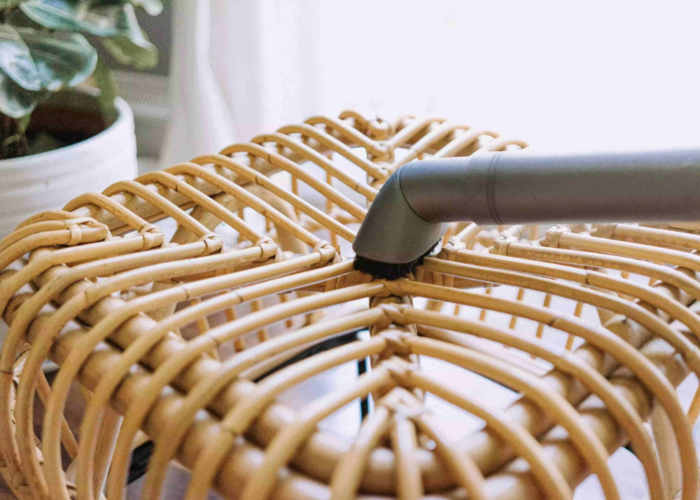
Step 2: Prepare a cleaning solution
Mix a small amount of mild soap or detergent with warm water in a bowl. Ensure that the solution is not too strong to avoid damaging the cane.
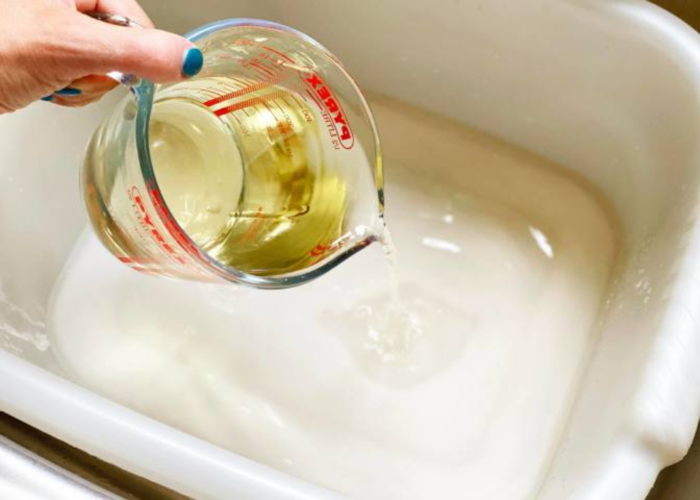
Step 3: Dust and wipe down
Dampen a soft cloth or sponge in the soapy water solution. Wipe down the entire surface of the cane furniture, paying attention to any stained or soiled areas. Be gentle to avoid excessive moisture on the cane, as it can lead to damage.
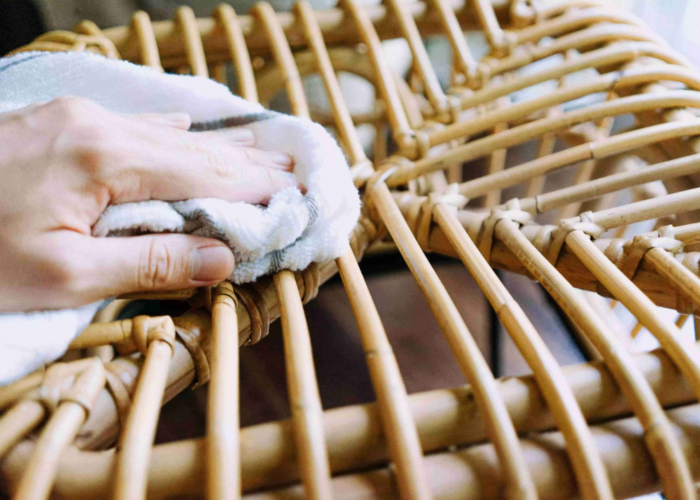
Step 4: Clean crevices with a brush or toothbrush
For intricate patterns or hard-to-reach areas, use a soft brush or toothbrush dipped in the soapy water solution. Gently scrub these areas to remove dirt or grime. Take care not to apply too much pressure to avoid causing damage to the cane.
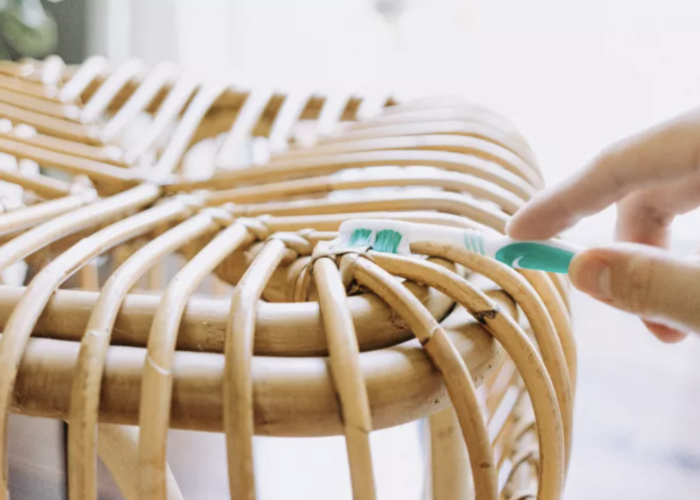
Step 5: Rinse with clean water
Once you’ve cleaned the entire surface, thoroughly rinse the cloth or sponge with clean water and wipe the furniture again. This helps remove any soap residue.
Step 6: Dry thoroughly
Allow the cane furniture to air-dry completely. Ensure that it is placed in a well-ventilated area to prevent the growth of mold or mildew. Avoid placing the furniture in direct sunlight, as excessive heat can cause the cane to dry out and become brittle.
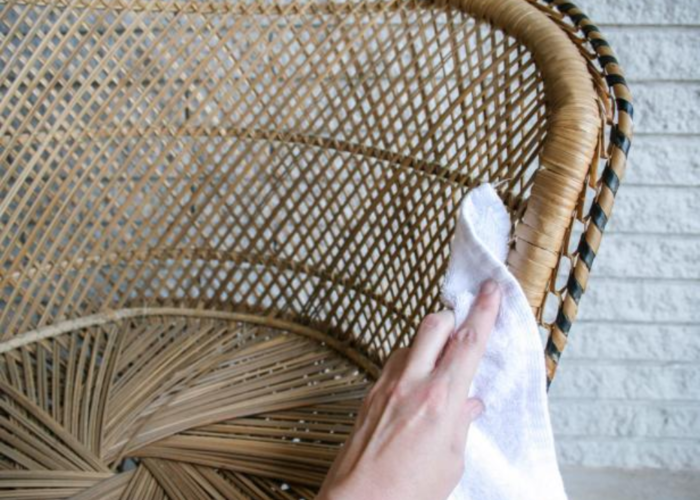
Step 7: Apply furniture polish or wax (Optional)
If desired, you can apply a small amount of furniture polish or wax to restore the shine and protect the cane. Follow the product instructions and use a soft cloth for application.
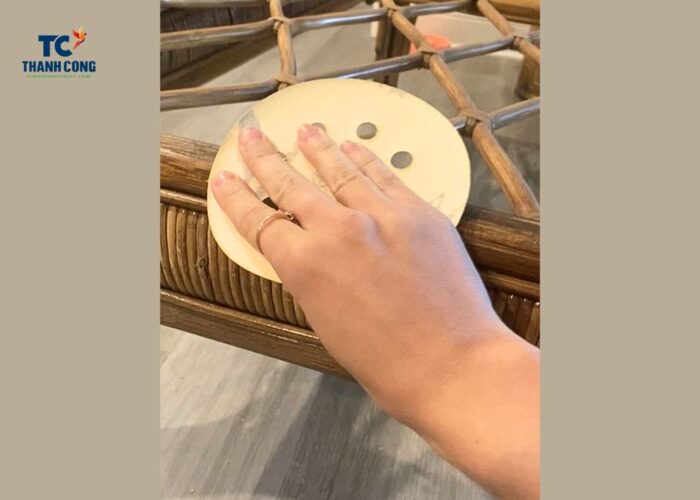
Step 8: Clean Intricate details with cotton swabs (Optional)
For extremely detailed or delicate areas, you can use cotton swabs dipped in the soapy water solution to gently clean and wipe away dirt.
Tips:
- Regularly dust and vacuum cane furniture to prevent the accumulation of dirt and debris.
- Avoid using abrasive cleaners or harsh chemicals, as they can damage the natural fibers of the cane.
- Protect cane furniture from direct sunlight and extreme humidity to prevent deterioration.
By following these steps and incorporating regular maintenance, you can keep your cane furniture looking clean, vibrant, and well-maintained for years to come.
2. How to take care of cane furniture?
Cane furniture, known for its natural and woven texture, requires proper care to maintain its beauty and longevity. Here’s a comprehensive guide on how to take care of your cane furniture:
- Dust Regularly: Dust your cane furniture regularly using a soft brush or a vacuum cleaner with a brush attachment. This helps prevent the accumulation of dirt and debris, which can lead to abrasion and wear over time.
- Avoid Direct Sunlight: Position your cane furniture away from direct sunlight. Prolonged exposure to sunlight can cause the cane to become dry and brittle, leading to cracks and damage. Consider using curtains or blinds to shield the furniture from harsh sunlight.
- Control Humidity: Cane furniture is sensitive to humidity. Avoid placing it in areas with extreme humidity levels, as this can cause the cane to swell or warp. Using a dehumidifier in humid environments can help protect your furniture.
- Clean Spills Immediately: If a spill occurs, clean it promptly to prevent stains. Use a soft, damp cloth to blot the affected area, and avoid rubbing, as this can spread the spill and damage the cane. Allow the furniture to air-dry thoroughly.
- Avoid Harsh Chemicals: When cleaning cane furniture, use a mild soap or detergent mixed with warm water to saturate the cloth and gently wipe it. Avoid using harsh chemicals or abrasive cleaners, as they can damage the natural fibers of the cane. Test any cleaning solution on a small, inconspicuous area first.
- Repair Loose Wrappings: If you notice loose or unraveling cane strands, consider repairing them promptly. Apply a small amount of wood glue to secure the loose strands back in place. Use small clamps to hold the repaired area until the glue dries.
- Apply Wax: Periodically, you may choose to apply a thin layer of furniture wax or polish to protect and enhance the shine of your cane furniture. Follow the product instructions, and use a soft cloth for application.
- Rotate Cushions and Pillows: If your cane furniture includes cushions or pillows, rotate them regularly to ensure even wear. This helps maintain the overall appearance and extends the life of the cushions.
- Store Indoors During Harsh Weather: If your cane furniture is intended for outdoor use, store it indoors during harsh weather conditions such as heavy rain or extreme cold. This protects the furniture from potential damage caused by exposure to the elements.
- Inspect Regularly: Periodically inspect your cane furniture for any signs of damage, such as loose joints or broken strands. Addressing issues promptly can prevent further deterioration.
By following these care tips, you can ensure that your cane furniture remains in excellent condition, providing a natural and inviting aesthetic to your living spaces for years to come. Regular maintenance and thoughtful placement contribute to the longevity and durability of your cane furniture.
3. FAQs
3.1 What do you treat cane furniture with?
One of the ways to care for rattan furniture is to use protective solutions to enhance its resistance to moisture, termites, mold, and UV rays. There are various types of protective solutions available for rattan furniture, but some common and effective ones include:
- Mild Soap and Water: A simple mixture of mild soap or detergent with warm water is often used for routine cleaning. This solution helps remove dirt and grime without causing damage to the natural fibers of the cane.
- PU Varnish Solution: This solution contains polyurethane, a synthetic resin that creates a glossy, durable coating for rattan furniture. PU varnish can help the furniture resist moisture, water, oil, acid, and alkali. It is suitable for both indoor and outdoor rattan furniture.
- Acrylic Varnish Solution: This solution contains acrylic, a synthetic resin that creates a thin, transparent, and flexible coating for rattan furniture. Acrylic varnish can help the furniture resist moisture, UV rays, oxidation, and corrosion. It is suitable for both indoor and outdoor rattan furniture.
- Beeswax Solution: This solution contains beeswax, a natural substance that creates a soft, smooth, and fragrant coating for rattan furniture. Beeswax solution helps the furniture maintain moisture, elasticity, and natural beauty. It is recommended for indoor rattan furniture.
- Wood Glue for Repairs: In cases where cane strands are loose or unraveling, wood glue can be used to secure them back in place. Apply a small amount of glue to the affected area, and use clamps to hold the repaired section until the glue dries.
To use these protective solutions for rattan furniture, clean the furniture before spraying or brushing the solution onto the surface. Allow the furniture to dry completely after applying the solution and avoid direct exposure to sunlight. It is advisable to perform protective treatment for rattan furniture at least once a year to maintain its quality and appearance.
3.2 Why does cane furniture smell?
Cane furniture may develop a smell for various reasons, and addressing the underlying causes can help eliminate or reduce the odor. Some common reasons why cane furniture might have a noticeable smell include:
- Natural Odor of Cane: Cane is a natural material, often derived from rattan plants, and it may have a distinct, earthy odor. This natural scent can be more noticeable when the furniture is new or has been recently exposed to certain conditions.
- Moisture and Mold: If cane furniture is exposed to excessive moisture or high humidity, it can lead to the growth of mold and mildew. The presence of mold can contribute to an unpleasant odor. Ensure that the furniture is kept in a well-ventilated area and is not subjected to prolonged damp conditions.
- Absorption of Surrounding Odors: Cane furniture is porous, and it can absorb odors from its surroundings. If the furniture is placed in an environment with strong odors, such as cooking smells or cigarette smoke, it may pick up and retain those scents.
- Storage Conditions: During storage or transportation, cane furniture might be exposed to different environments or materials that can impart odors. It’s essential to store the furniture in a clean, dry place with proper ventilation.
- Chemical Treatments: Sometimes, manufacturers apply chemical treatments or finishes to cane furniture, which can emit odors. These odors may dissipate over time but can be noticeable initially.
3.3 Can you pressure wash cane furniture?
Pressure washing cane furniture is generally not recommended. Cane furniture is made from natural materials, often derived from rattan, and is woven to create intricate patterns. The high pressure of a pressure washer can potentially damage the delicate fibers, leading to unraveling, breakage, or deformation of the furniture.
Here are some reasons why pressure washing is not advisable for cane furniture:
- Damage to Natural Fibers: The forceful spray of a pressure washer can be too harsh for the natural fibers of cane. This can result in fraying, breakage, or loosening of the woven strands, compromising the structural integrity of the furniture.
- Water Intrusion: Cane is porous, and pressure washing can force water into the fibers. Excessive moisture can lead to swelling, warping, or the development of mold and mildew, causing further damage.
- Loss of Finish or Stain: If your cane furniture has a protective finish or stain, pressure washing can strip away this coating. This can leave the furniture more susceptible to the damaging effects of the sun, moisture, and other environmental factors.
If you have any further questions, don’t hesitate to send thanhcongcraft an email us at info@thanhcongcraft.com or message us at WhatsApp: +84967485411. Hope to serve you soon! Best regard!


